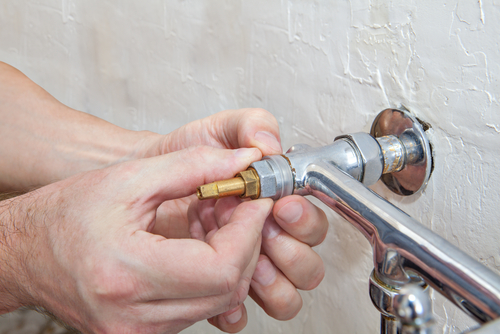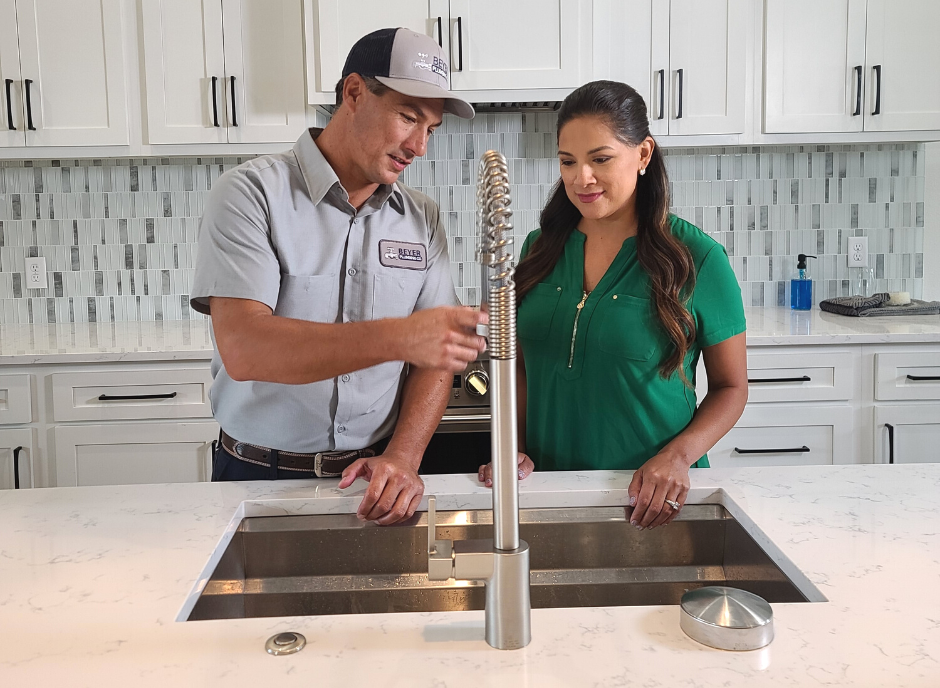My Causes Behind Correcting a Faulty Faucet
My Causes Behind Correcting a Faulty Faucet
Blog Article
We've discovered this article involving Leaky Faucets: Why They Happen & What to Do About Them below on the web and thought it made good sense to share it with you on this site.

Leaking faucets might look like a small hassle, yet their influence goes beyond just the aggravation of the sound. From wasting water to sustaining unneeded monetary prices and wellness dangers, ignoring a leaking tap can lead to numerous repercussions. In this short article, we'll delve into why it's vital to address this common house problem without delay and effectively.
Waste of Water
Ecological Influence
Leaking taps add substantially to water waste. According to the Environmental Protection Agency (EPA), a solitary faucet trickling at one drip per second can throw away greater than 3,000 gallons of water each year. This not just stress water sources yet also impacts ecological communities and wildlife depending on them.
Financial Costs
Boosted Water Costs
Past the ecological impact, trickling taps can pump up water expenses considerably. The gathered wastefulness over time translates right into higher utility expenses, which could have been avoided with timely repairs.
Possible Residential Or Commercial Property Damage
Moreover, extended leaking can cause damage to components and surfaces surrounding the faucet. Water buildup can trigger discoloration, deterioration, and even structural issues if left neglected, leading to additional fixing costs.
Wellness Problems
Mold And Mildew and Mildew Growth
The consistent presence of moisture from a trickling faucet creates a perfect atmosphere for mold and mildew and mildew growth. These fungi not just compromise interior air top quality but also position wellness threats, especially for individuals with respiratory conditions or allergies.
Waterborne Illness
Stationary water in trickling taps can become a breeding ground for germs and various other pathogens, increasing the threat of waterborne diseases. Contaminants such as Legionella bacteria grow in stationary water, possibly causing severe diseases when ingested or inhaled.
DIY vs. Professional Repair work
Benefits and drawbacks of Do It Yourself Repair
While some may attempt to deal with a trickling faucet themselves, do it yourself repair work include their very own set of challenges. Without proper expertise and devices, DIY attempts can exacerbate the issue or lead to insufficient repair services, extending the issue.
Benefits of Working With an Expert Plumber
Employing an expert plumber guarantees that the underlying cause of the trickling faucet is dealt with properly. Plumbing professionals possess the knowledge and devices to detect and repair tap concerns effectively, saving time and decreasing the risk of additional damage.
Step-by-Step Overview to Fixing a Dripping Tap
Tools Needed
Prior to trying to deal with a leaking faucet, collect the essential devices, including a flexible wrench, screwdrivers, replacement components (such as washing machines or cartridges), and plumber's tape.
Typical Faucet Issues and Their Solutions
Recognize the sort of faucet and the certain problem creating the drip. Common issues include damaged washing machines, rusty valve seats, or malfunctioning O-rings. Refer to maker guidelines or on the internet tutorials for detailed support on repairs.
Safety nets
Routine Upkeep Tips
To prevent trickling faucets, carry out regular upkeep such as cleaning aerators, examining for leakages, and changing damaged parts without delay. Furthermore, consider mounting water-saving gadgets or updating to more reliable components.
Importance of Prompt Fixes
Dealing with leaking taps as soon as they're observed avoids more water waste and prospective damages, eventually saving both water and cash in the long run.
Effect On Residential Property Worth
Assumption of Well-Maintained Residential Or Commercial Property
Preserving a residential property in good condition, including addressing upkeep problems like leaking faucets, boosts its viewed value and charm among possible buyers or occupants.
Impact on Resale Worth
Characteristics with well-kept plumbing fixtures, including faucets, command higher resale values in the real estate market. Resolving dripping taps can add to a positive impact during residential property inspections and negotiations.
Environmental Obligation
Specific Contribution to Conservation
Taking responsibility for fixing trickling taps aligns with broader initiatives toward water preservation and ecological sustainability. Every person's activities jointly make a considerable influence on maintaining valuable sources.
Sustainable Living Practices
By prioritizing timely repairs and embracing water-saving behaviors, individuals contribute to sustainable living techniques that benefit both present and future generations.
Verdict
Addressing a leaking faucet surpasses simple convenience; it's a crucial action toward preserving water, reducing financial costs, and guarding health and wellness and property. Whether with do it yourself repair work or professional support, taking action to repair trickling faucets is a little yet impactful method to promote liable stewardship of resources and add to a healthier, much more sustainable future.
How to Fix a Leaky Faucet: Step-by-Step Repair Guide
A leaky faucet may seem like a simple annoyance, but if it's not fixed promptly, that leak could cost hundreds to potentially thousands. From water damage to mold, mildew, and high water bills, even a tiny leak can be catastrophic if left unattended. Damage like this can even affect the overall value of your home, so it's important to take the right approach for leaky faucet repair. You may need the help of a plumber in some cases, but we've got a few tips you can try on how to fix a leaky faucet before calling the pros.
Four Faucet Types
When you're learning how to fix a leaky faucet, the first step is knowing what kind of faucet you're working with! There are four common types.
Cartridge Faucets
Cartridge faucets come in one- or two-handled varieties. In one-handled cartridge faucets, hot and cold water combines in a single cartridge. In the two-handled versions, hot and cold water are controlled separately and mixed in the faucet.
Ball Faucets
Ball faucets have a single lever you push up and down to adjust the pressure and rotate to change the temperature. A slotted metal ball controls the amount of water allowed into the spout.
Compression Washer Faucets
They're the oldest type of faucet, but they're still used in many homes — especially older ones. Compression faucets have two separate handles that, when turned, raise or lower the washer that seals a water valve. This valve stops water from flowing through the faucet when it is turned off.
Disc Faucets
Disc faucets rarely need to be repaired due to their maintenance-free design. The water flow is controlled by two discs — the upper one raises and lowers against a fixed lower disc, creating a watertight seal. If your disc faucet starts leaking, you may need to replace the seals or clean residue buildup from the inlets.
Fixing a Leaky Faucet
Step 1: Turn Off the Water
Whether you're learning how to fix a leaky bathtub faucet or how to fix a leaky kitchen faucet, always turn off the water supply to your working area when you're fixing a leak. The last thing you want is a flood added to your list of things to fix.
Look for the shutoff valves below your sink or around the tub and turn them clockwise to stop the water flow. If your faucet doesn't have shutoff valves, you may need to turn off the water for the whole house. Check to make sure it's off by turning the faucet on. If nothing comes out, you're ready to start the repair.
Step 2: Take Apart the Faucet
How you disassemble your faucet depends on the type of fixture you have. You can use a flathead screwdriver to remove the caps on top of the handle or handles for cartridge and compression faucets. Inside, you should see handle screws. Unscrew these with a screwdriver to remove the handle.
Disc- and ball-style faucets will typically have an inlet screw near the handle, and removing that will reveal the interior of the faucet.
Detach the Valve Stem
For cartridge- and compression-style faucets, you'll see the inner valve stem or cartridge once you remove the faucet handles. If you have a compression faucet, unscrew the brass valve stem. If you have a cartridge faucet, pull out the cartridge. If your cartridge has been in place for a while, it may require some tools or extra force to remove it due to mineral deposits.
Examine and Replace Parts
Once you've removed the parts, check them out to confirm what needs to be replaced. You may see corroded rubber washers, O-rings, stems, or cartridges. On a ball-style faucet, check the seats and springs for damage.
If you need to repair a leaky disc faucet, check the inlet and seals on the lower disc.
Once you determine what parts must be replaced, visit your local hardware store. Bring the damaged parts with you to ensure you can purchase the correct components to replace them.
Clean Valves and Faucet Cavity
If you've removed a stem or cartridge, you may notice mineral buildup in the faucet's threads. Use white vinegar to clean the valve seat by soaking it for a few minutes, then scrub it away with a soft toothbrush and rinse with warm water. You can also clean the interior of the faucet in the same way.
Reassemble the Faucet
Once your faucet is cleaned and the required parts have been replaced, it's time to reassemble it. Put the pieces back together and slowly turn the water supply back on. Doing this slowly is crucial because too much initial water pressure can damage the new hardware you've just installed.
https://homewarranty.firstam.com/blog/how-to-fix-leaky-faucet

Do you like reading up on ? Put feedback further down. We will be happy to see your insights about this post. Hoping that you visit us again in the future. Kindly take the time to share this blog if you appreciated it. Thanks so much for your time invested reading it.
Report this page